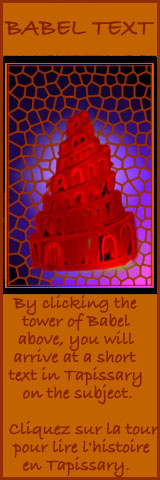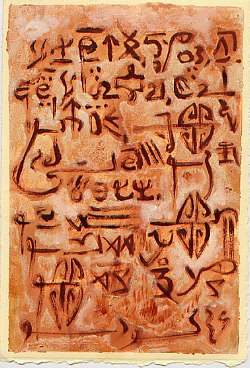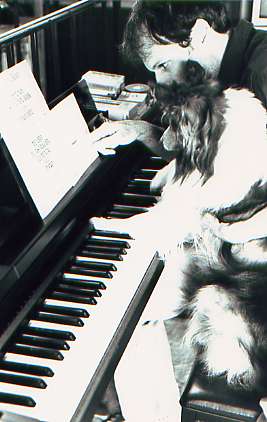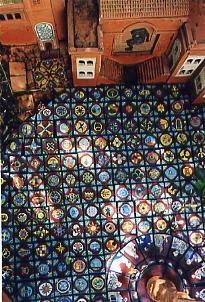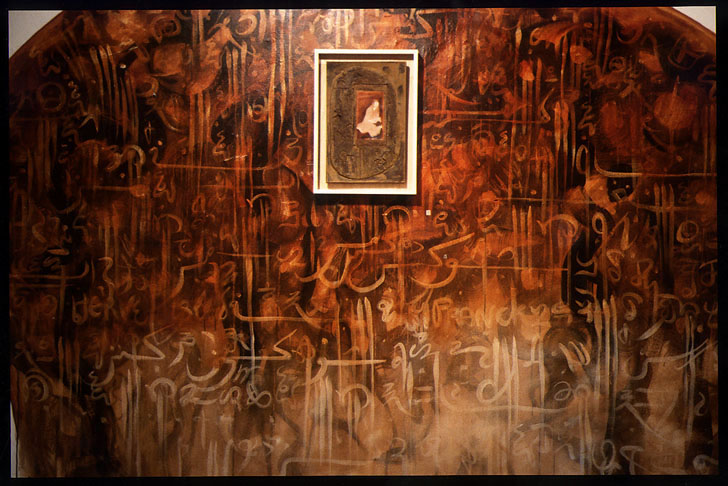
The picture above will take you to the Exhibits page where you can read about the Tapissary show I'd done in New York.
Cliquez sur l'image du rouleau en haut pour avoir accès aux infos de l'expo Tapissary à New York en 2004.
Pour la traduction en Français du texte à droite, cliquez sur cette paragraphe bleue.
TAPISSARY
The photo above is a wall at the Amos Eno Gallery in NYC that I had painted in Tapissary. It was for my solo exhibition entitled "Oils on Tablets" in 2000. For this exhibit I painted directly onto all of the gallery's walls with acrylic colors making bulbous 8 to 10 foot high texts which served as backdrops for the ceramic tablets I hung before them. After the show of course, the walls were repainted white, so these large texts no longer exist.
In 1977 I started inventing a pictographic language called Tapissary based on American Sign Language for the Deaf. I was studying to become an interpreter. I enjoyed the beautiful movements of Sign Language and experimented with stylizing motion into script. I continued my project incorporating ancient Egyptian and Chinese characters into the growing dictionary, while reconstructing the shapes of these new additions either slightly or drastically to conform to the elemental style of written Tapissary. Combined with my own simplified pictures, the count of characters (which I call celloglyphs) is around 8,000. The language is read from left to right, then right to left alternately down the page. This forward and backward traveling is easy on the eyes. On the lines you read "backwards" I have included special forms based on the principles of the left traveling languages: Hebrew, Ottoman Turkish and Arabic. I use Arabic most often because its cursive style often forms words into a continuous unit, like a ribbon of arabesque design. They are primed to be assimilated into the hieroglyphic context. Another advantage to the Arabic cursive style, is that quite often one word can be elongated to fit several other celloglyphs into its 'arms' therby completing a phrase in one drawing. You will see this more clearly by checking out the script on pages 8 and 9 of "The Piano Competition" to the left. While the Middle East has provided me a template for the direction I write my hieroglyphs, it is the Japanese system of writing which most inspired my approach to the way Tapissary is used as a written language. In Japanese, thousands of kanji (the characters borrowed from the Chinese writing system) are supported with a phonetic syllabary of 50 letters called Hiragana. I have adapted this Japanese idea into my language. The 8,000 celloglyphs in Tapissary do not cover all possible vocabulary words of course, and so for those without a celloglyph, I invented a syllabary of some 400 letters. From these letters, any word can be phonetically constructed.
Before beginning the hieroglyphic language of Tapissary, I'd worked on many previous creations that were spoken with terribly complex grammars. Slavamazic had over 30 cases, as an example. My "Circular Accusative" alone, boasted some 18 forms, dependent upon 3 classes of verbs. Prepositions had instigators and receptors to pictorially map the relationships of position. Creating viably bizarre structures kept me stimulated. It would be years before discovering linguistic economy coupled with a growing interest in the expressive qualities and nuance-rich treasures in my native language of English. Instead of escaping what I'd previously considered the mundane, I embraced my heritage. The original Ameslan/Slavamazic/Turkish derived grammar of Tapissary begun in 1977, slowly yielded itself to English for the sake of instant access to my thoughts: after all, I was often using Tapissary as a practical tool for recording entries into my diaries. However, with that said, the persistent desire for my own grammar deepened. Now I wanted something outside the scope of variations on foreign grammars. The years-old geometric religion I'd created for my clay civilizations offered a challenging solution. I began assimilating this nonlinguistic, yet culturally relevant element into Tapissary. It gave me a fresh approach to grammar with an authentically indigenous perspective. Around 1990, Tapissary began to spin this new cyclic support into English grammar. They coexist in a symbiotic relationship; the cycle feeding on the linguistic system of English as its life blood, while the imported English grammar stagnates in a purely linear mode if not activated by the cycle. For instance, if I choose not to decline the coordinates on the cycle, ignoring their availability, and let my sentences rest wholly within English, then by default the economic nature of the cycle is set at its first coordianate, and doesn't move. This effectively states that all the sentences in this position are manifestations of the material, presenting the story or communication as a list of facts, specifically devoid of other qualities. So if, in the sentence at rest you declare: "That man stole my wallet", it would automatically define the statement as a statistic rather than one of loss or emotion. The same would apply to an apparent statistic, such as: "I bought some bread today." If rendered as a resolution on the cycle, this will alert the listener to deduce that buying the bread brought some important project to fruition. The way cycles play off one another and blend into the base grammar is a natural extension of what I have described. Perhaps the most valuable usage of the cycles is not revealed through individual sentence dynamics, but rather the cycle's progression through a suite of communications, unifying them in chords of relationship. I call this 'keys', and it is the most gratifying aspect of constructing Tapisreal texts.
The name Tapissary comes from the French "Tapisserie" which means tapestry. I love the way tapestries convey a story through pictures woven into flexible warm fabric. Tapissary also deals with communication through pictures. Its cyclic grammar spins itself into the base grammar, and in this way is not dissimilar to the weaving process of the warp and weft on a loom composing an integrated whole.
It's an interesting experience to read via symbols. I use these hieroglyphs to translate texts, and to write my diaries. Only recently however, have I been examining Tapissary as an artistic tool. It is as much a part of me as the experiences recorded in the diaries, or my relation to painting and sculpture. Such devotion to this rather abstract and faithful companion of 28 years is surfacing as one of my icons.
Tapissary is a language of the journal that over the decades has allowed one man access to the other younger men that he was in the past.
tapisreal pronunciation pronoñsyajaja dë tapsari
Click on the button below to get an overview of the phonetic system in Tapissary. [please note that the button that says 'click here' seems to be malfunctioning. If you type in the address manually, you will be able to access this page.]
www.travisstudio.com/tapissary
/tap_pronounce.html

For a brief explanation of Tapissary in Japanese, click on the button below.

Nihongo no eikyo

